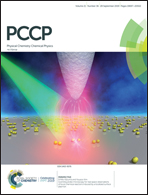Halide anion discrimination by a tripodal hydroxylamine ligand in gas and condensed phases†
Abstract
Electrospray ionization of solutions containing a tripodal hydroxylamine ligand, H3TriNOx ([((2-tBuNOH)C6H4CH2)3N]) denoted as L, and a hydrogen halide HX: HCl, HBr and/or HI, yielded gas-phase anion complexes [L(X)]− and [L(HX2)]−. Collision induced dissociation (CID) of mixed-halide complexes, [L(HXaXb)]−, indicated highest affinity for I− and lowest for Cl−. Structures and energetics computed by density functional theory are in accord with the CID results, and indicate that the gas-phase binding preference is a manifestation of differing stabilities of the HX molecules. A high halide affinity of [L(H)]+ in solution was also demonstrated, though with a highest preference for Cl− and lowest for I−, the opposite observation of, but not in conflict with, what is observed in gas phase. The results suggest a connection between gas- and condensed-phase chemistry and computational approaches, and shed light on the aggregation and anion recognition properties of hydroxylamine receptors.



 Please wait while we load your content...
Please wait while we load your content...